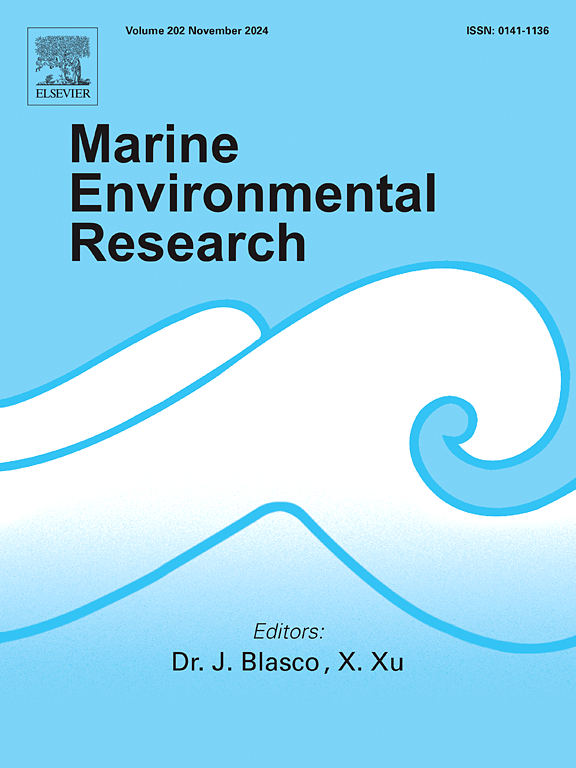Integrating traditional and innovative monitoring approaches to monitor the marine biodiversity in the Tyrrhenian Sea (Mediterranean sea)
IF 3
3区 环境科学与生态学
Q2 ENVIRONMENTAL SCIENCES
引用次数: 0
Abstract
The Mediterranean Sea, a global biodiversity hotspot, is increasingly threatened by anthropogenic pressures, leading to a decline in marine biodiversity and ecosystem services. In response, effective monitoring and conservation strategies, including citizen science initiatives, are crucial for understanding and mitigating these impacts. This study presents the Marine Adventure for Research and Education (M.A.R.E.) initiative, which integrates public participation in marine biodiversity monitoring through visual surveys and environmental DNA (eDNA) sampling. Novel species-specific primers were developed to target key species, including Risso's dolphin, fin whale, basking shark, loggerhead sea turtle, and sperm whale. Over three months, approximately 100 participants contributed to the detection of endangered marine species, including the loggerhead sea turtle, striped dolphin, fin whale, and basking shark, in the Tyrrhenian Sea. Thus, eDNA analysis proved to be a highly sensitive and non-invasive method for detecting a wide range of species, complementing traditional visual surveys. As a matter of fact, the second most detected species with molecular analyses was the Risso's dolphin, an elusive species previously underreported in the region. Thus, this study suggests that eDNA technique might be considered a promising technique to monitor the Risso's dolphin distribution in the Mediterranean Sea.

结合传统和创新监测方法监测第勒尼安海(地中海)的海洋生物多样性
作为全球生物多样性热点地区,地中海正日益受到人为压力的威胁,导致海洋生物多样性和生态系统服务功能下降。因此,有效的监测和保护策略,包括公民科学倡议,对于理解和减轻这些影响至关重要。本研究提出了海洋探险研究和教育(M.A.R.E.)倡议,该倡议通过视觉调查和环境DNA (eDNA)采样将公众参与到海洋生物多样性监测中来。新的物种特异性引物开发针对关键物种,包括里索海豚,长须鲸,姥鲨,红海龟和抹香鲸。在三个多月的时间里,大约100名参与者参与了对第勒尼安海濒危海洋物种的探测,包括红海龟、条纹海豚、长须鲸和姥鲨。因此,eDNA分析被证明是一种高度敏感和非侵入性的方法,用于检测广泛的物种,补充了传统的视觉调查。事实上,在分子分析中发现的第二多的物种是里索海豚,这是一种以前在该地区被低估的难以捉摸的物种。因此,本研究表明,eDNA技术可能被认为是监测地中海里索海豚分布的一种有前途的技术。
本文章由计算机程序翻译,如有差异,请以英文原文为准。
求助全文
约1分钟内获得全文
求助全文
来源期刊

Marine environmental research
环境科学-毒理学
CiteScore
5.90
自引率
3.00%
发文量
217
审稿时长
46 days
期刊介绍:
Marine Environmental Research publishes original research papers on chemical, physical, and biological interactions in the oceans and coastal waters. The journal serves as a forum for new information on biology, chemistry, and toxicology and syntheses that advance understanding of marine environmental processes.
Submission of multidisciplinary studies is encouraged. Studies that utilize experimental approaches to clarify the roles of anthropogenic and natural causes of changes in marine ecosystems are especially welcome, as are those studies that represent new developments of a theoretical or conceptual aspect of marine science. All papers published in this journal are reviewed by qualified peers prior to acceptance and publication. Examples of topics considered to be appropriate for the journal include, but are not limited to, the following:
– The extent, persistence, and consequences of change and the recovery from such change in natural marine systems
– The biochemical, physiological, and ecological consequences of contaminants to marine organisms and ecosystems
– The biogeochemistry of naturally occurring and anthropogenic substances
– Models that describe and predict the above processes
– Monitoring studies, to the extent that their results provide new information on functional processes
– Methodological papers describing improved quantitative techniques for the marine sciences.
 求助内容:
求助内容: 应助结果提醒方式:
应助结果提醒方式:


